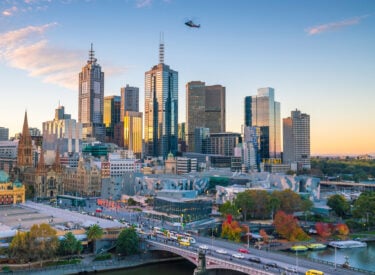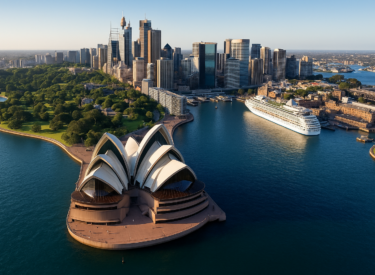
Key takeaways
The nine-to-five model fades into history.
Knowledge work shifts to output-based rather than time-based, recruitment becomes skills-verified rather than CV-driven, and permanent employment gives way to short-term, adaptable, project-based work.
Offices survive—but only as collaboration hubs focused on creativity and connection.
Smaller families, delayed parenting, and longer lifespans shift planning, policy, and housing preferences.
The Australian Dream continues its evolution: fewer large suburban blocks, more compact homes, and a big rise in townhouses and apartments located closer to amenity-rich urban areas.
Plastic packaging, petrol cars, cash, car ownership, and even screens gradually vanish.
Electric, autonomous transport becomes normal, biodegradable packaging replaces plastic, and digital payments fully dominate. Many of today’s “ordinary” items become museum pieces by the 2040s.
Health systems shift from treating illness to preventing it, using AI-enhanced lifelong data, wearables, robotics, and automation to manage an ageing population.
Education moves away from essays and memorisation toward creativity, collaboration, and micro-credentials as AI reshapes both learning and assessment.
Live TV declines to a handful of communal events like sport, while AR glasses and personalised media feeds replace screens. Technology deepens personalisation, but also fuels a counter-movement of “digital minimalists.”
Meanwhile, governments begin relying on AI for transparency, fairness, and even oversight—raising profound questions about trust and democracy.
Picture this - it’s 2045.
You’re walking through a museum with your grandkids, and instead of staring at ancient artifacts or dinosaur fossils, they’re peering into glass cases displaying remote controls, petrol pumps, plastic packaging, and car keys.
They’ll look up at you in disbelief and ask, “Did you really use these?”
You’ll smile, remembering a time when people actually drove their own cars, wrapped food in plastic, and carried wallets full of cash.
The pace of change has never been faster.
What we consider everyday conveniences today will soon be as quaint as a rotary phone.
And while some of these changes are exciting, others will reshape our work, homes, and habits in ways that will demand adaptation and resilience.
For weekly insights, subscribe to the Demographics Decoded podcast, where we will continue to explore these trends and their implications in greater detail.
Subscribe now on your favourite Podcast player:
Work as we know it: gone
The traditional nine-to-five, five-day work week is already under threat.
But by the 2040s, it will be the exception rather than the rule.
As Simon Kuestenmacher explains in our latest Demographics Decoded episode, “Few and fewer people work nine to five… we’re becoming heaps flexible already.”
Hybrid work and technology have blurred the line between office and home life, and the idea of “spare time” is becoming increasingly abstract.
We’ll still see a divide between types of work: service roles such as retail or security will remain time-based and physical, but the bulk of the knowledge economy will move towards output-driven employment.
The concept of sitting in a cubicle for eight hours just to “show face” will feel absurd.
That’s not without its challenges.
When your phone pings with a message at 9 p.m., it’s hard to know when work ends and life begins.
Simon notes that even countries with “right to disconnect” laws, like France, are finding it hard to enforce boundaries when everyone’s digitally tethered.
The future of work will be more flexible, but also more fluid, and more demanding of self-discipline.
Offices will survive, but barely recognisable
The office isn’t disappearing, but it’s evolving.
The open-plan trend that replaced cubicles didn’t quite work, and remote work has forced companies to rethink the role of physical space.
Simon predicts fewer desks, more collaboration zones, and spaces that encourage face-to-face creativity.
“AI takes away the boring, repetitive tasks,” he says, “so offices will focus on human interaction, brainstorming, problem-solving, and connecting.”
Think fewer rows of computers and more meeting rooms, breakout lounges, and coffee corners.
In fact, the future workplace might feel more like a café than a corporate headquarters.
Jobs for life? Forget it
The notion of sticking with one employer for decades is already outdated.
As businesses face rapid technological shifts, permanent contracts will give way to project-based or flexible employment.
Companies will want adaptability; workers will want autonomy.
As Simon notes:
“Businesses find it increasingly hard to forecast the future. So they’ll want their workforce always on call, ready to adapt to technological change.”
Even recruitment will look nothing like today’s process.
Simon points out the absurdity of the current system:
“The company uses AI to write a job description, and applicants use AI to tailor their CVs. It’s essentially two AIs talking to each other.”
Instead, expect digital credentialing: verified skills, projects, and experience stored in secure online profiles, potentially blockchain-linked.
Employers will evaluate potential hires more holistically, relying less on résumés and more on human connection.
The irony is that the future of hiring may feel more human, not less.
The changing shape of home and family
The nuclear family, mum, dad, and kids, won’t disappear, but it will represent a smaller portion of society.
“Families will still exist,” Simon explains, “but they’ll be smaller, and the share of society in that life stage will shrink.”
That’s due to delayed parenthood, longer lifespans, and more people choosing to live single or child-free.
As millennials finish their family years and Gen Z steps in later, family-centred policies and marketing will lose dominance.
And that shift will reshape how and where we live.
The quarter-acre block, once the Australian dream, has been shrinking for decades.
“The big suburban lawn is a relic of the past,” says Simon. New estates with 350-square-metre lots are the norm.
Australians are trading space for place, smaller homes, closer to jobs, schools, cafés, and cultural life.
The future of the “family home” is vertical, townhouses and apartments, not detached houses with backyards.
Shopping will be about experience, not just retail
Traditional shopping will also change.
While online retail already dominates, it won’t eliminate physical stores entirely.
“Only around 16% of all sales happen online,” Simon notes, “and even if that continues to grow, we’ll still crave the physical experience, touching, trying, and exploring.”
Big malls that reinvent themselves as entertainment and social destinations will thrive, those combining shopping with dining, cinemas, play zones, and even coworking spaces. But the humble suburban strip mall is in trouble.
“It’s a big part of Australian life,” says Simon, “but it’s under massive threat.”

Goodbye to plastic, petrol, and cash
Few environmental issues unite the world like the fight against plastic pollution.
“There’s no debate about it,” says Simon. “Plastic in the oceans is shocking.”
Innovators are already creating biodegradable packaging that matches plastic’s performance, but consumer habits are proving harder to change.
“People rejected paper-based strawberry containers,” he notes, “because they couldn’t rinse them under water like they did with plastic.” Old habits, it seems, die hard.
In parallel, petrol stations will become rarer as electric vehicles and automation take over.
And self-driving cars? They’re inevitable.
“Why should you drive yourself,” Simon asks, “when you can use that time to work, sleep, or relax?”
Even car ownership itself may fade.
“If private ownership disappeared, we’d need only about 20% of today’s vehicles,” he explains. “That would free up enormous urban space currently used for car parks.”
And when you pay for your next ride, don’t bother with cash.
Physical money is nearly extinct.
Kids already pretend to “tap” their toys with fake phones when playing shop.
Still, Simon argues for keeping some physical cash: “It’s vital for national sovereignty, a backup in case digital systems fail.”
Health care will be predictive, not reactive
The health system of the future won’t just treat illness, it will anticipate it.
Your smartwatch and wearable sensors will constantly feed data into an AI-driven health record accessible to you and your doctor.
“All your health information should be collected and stored for life,” says Simon. “That allows AI to calculate your risk of disease based on your genetics and lifestyle and recommend tailored prevention.”
As our population ages, technology will fill the gap left by a shrinking care workforce.
Exoskeletons will help the elderly walk, AI companions will monitor vital signs, and robotics will support home-based care.
“We can’t take the current aged-care model into the future,” warns Simon. “There are too many who need care and too few who provide it.”
Education will be transformed
Our schools and universities are next in line for disruption.
The current education model, long lectures, standard tests, and essay-based grading, simply won’t survive.
“Students already use AI to write essays,” Simon observes, “and lecturers use AI to mark them. It’s ridiculous.”
Education will shift towards assessing creativity, problem-solving, and collaboration, skills AI can’t easily replicate.
At the same time, not everyone will need a university degree.
With more than half of Australian school leavers heading to uni, the prestige has diluted.
Expect shorter, stackable micro-degrees, real-time upskilling, and a blend of online and face-to-face learning.
A glimpse into future leisure and media
Television as we know it is already on life support.
On-demand streaming dominates, and Simon believes “the only reason to watch live TV anymore is sport.”
But even that’s changing.
Sensors, AI referees, and smart equipment already ensure precision, though Simon adds with a laugh, “Part of the joy of sport is still being angry about the referee’s bad call 20 years later.”
Screens themselves may disappear, too.
Augmented reality glasses, perhaps your next “phone”, will project personalised, private displays. That could mean fewer physical devices and less electronic waste.
But as Simon warns, it might also deepen our tech dependency.
A “digital Amish” movement may emerge: people who deliberately live with minimal tech to reclaim their attention and humanity.
Politics and the algorithmic future
Finally, politics.
It’s hard to imagine democracy untouched by algorithms.
“Should we leave all power with politicians,” Simon asks, “or build a digital exoskeleton, AI that checks their actions for fairness and truth?”
While Australia may move slowly, smaller nations like Estonia or Iceland could lead the way in AI-assisted governance.
It raises profound questions about privacy, accountability, and trust, questions societies must confront soon.
Final thoughts
Over the next two decades, we’ll witness the quiet extinction of countless everyday objects and habits: handwritten signatures, plastic packaging, petrol cars, coins, and maybe even passwords.
But as Simon reminds us, every disappearance brings opportunity.
Our challenge will be to preserve what matters, human connection, fairness, and creativity, while embracing technologies that make life safer, cleaner, and smarter.
The Museum of the Future will be fascinating to visit.
But it’s the world outside its doors, the one we’re building today, that will really tell the story of who we’ve become.
If you found this discussion helpful, don't forget to subscribe to our podcast and share it with others who might benefit.
Subscribe now on your favourite Podcast player:














